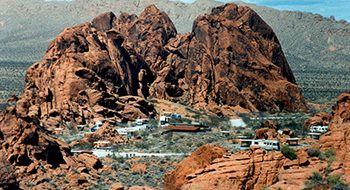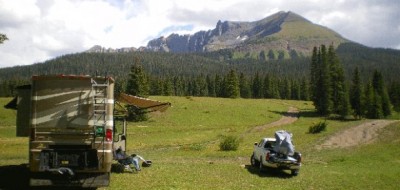By Bob Difley
 When you were scouring the campground directories for campsites–especially those in National Parks, Monuments, and Forests–to spend a few days or for one-nighters when traveling and you see restrictions on maximum size allowed, such as “Maximum size 27 feet” did you cross it off your list of potential camping locations? If so, you may have missed an opportunity to visit what might be a wonderful national treasure or a nesty, forest campsite beside a tumbling stream.
When you were scouring the campground directories for campsites–especially those in National Parks, Monuments, and Forests–to spend a few days or for one-nighters when traveling and you see restrictions on maximum size allowed, such as “Maximum size 27 feet” did you cross it off your list of potential camping locations? If so, you may have missed an opportunity to visit what might be a wonderful national treasure or a nesty, forest campsite beside a tumbling stream.
The maximum length referred to means that all–or most–of the campsites in the campground will accommodate that length. But . . . SOME will also accommodate longer lengths, sometimes much longer. Those who write the rules do not want to officially include longer lengths when maybe only three or four campsites will fit longer lengths, and if those are taken but smaller ones remain open, they may get in a tangle with RVers with a longer rig urging them to move someone with a shorter rig out of the larger site and into a smaller site. Or, when those with larger rigs show up and find there are only a few that fit the maximum size stated and they are taken.
Whatever the reasons–not that I blame them at wanting to avoid such hassles–knowing this does open up some options. If you can fit into the campsite they won’t tell you to leave. And often, the measurement is made from the wheel barrier at the rear of the campsite to the front, the length of the pad itself . So, when you back in, your overhang extends over the barrier adding quite a few feet to the length that will fit. But watch out for those wood posts that some campgrounds use. Your overhang may not clear them. And there might be several sites that are long enough even without the overhang factor.
When you arrive at a campground that has a stated maximum length, drive around the campground and if you find one you fit into–no extending into the road, into foliage in the rear, or onto other obstructions–take it. It’s unlikely that you will find a host or ranger that will ask your length–unless they know exactly which sites are open and whether you will fit in any of them.
In national parks, it’s a bit more difficult, especially on busy holidays and weekends. If the park is filled everyday those that assign campsites may hold to the size maximum to reduce chaos, so plan to arrive early mid-week, before they start to fill up, when you can scout for larger sites on your own.
For more RVing articles and tips take a look at my Healthy RV Lifestyle website, where you will also find my ebooks: BOONDOCKING: Finding the Perfect Campsite on America’s Public Lands (PDF or Kindle), 111 Ways to Get the Biggest Bang for your RV Lifestyle Buck (PDF or Kindle), and Snowbird Guide to Boondocking in the Southwestern Deserts (PDF or Kindle), and my newest, The RV Lifestyle: Reflections of Life on the Road (PDF or Kindle reader version). NOTE: Use the Kindle version to read on iPad and iPhone or any device that has the free Kindle reader app.
NOTE: It appears that the “Comment” section of the blog is not currently working and the blog management has so far been unable to fix it. If you would like to comment directly to me you can use my website email address: hrvlcontact at gmail.com (you know how to write it correctly). I would enjoy hearing from you.

